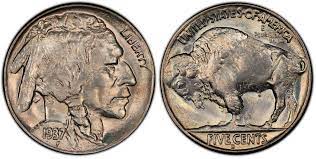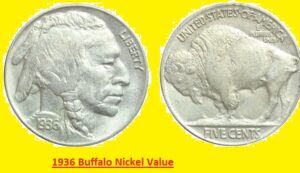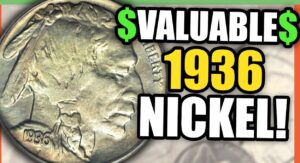Hello readers welcome to the new post. Here we will learn 1936 Buffalo Nickel Value – Discover Your Buffalo Nickel Worth. The 1936 Buffalo nickel is called Indian head nickel, and its value is different based on features, mint mark location and quality. The 1936 Buffalo Nickel will be covered for its history, design, and, most importantly, its worth. Let’s get started with 1936 Buffalo Nickel Value
History of the Buffalo Nickel

The nickel coins first time created in 1966 after releasing of Shield nickels in circulation. The US Mint made Liberty Head Nickels from 1884 to 1912, when the first Buffalo nickel was made.
The designer James Earle Fraser made Buffalo nickels then the USA Mint made coins from 1913 to 1938.
1936 nickels were made during the difficult time of the USA economy, but in this larger number of nickels made. In this year proof coins also made after 1916.
After two years minting of buffalo nickels stopped. In 19936 there were 118,997,000 1936 No Mint mark nickel, 1936 nickel proof 4,420, 1936 S nickel 14,930,000, 1936 D nickel 24,814,000, and a total of 158,745,420 coins made.
1936 Buffalo Nickel Features
Obverse Of 1936 Buffalo Nickel
The front side of these coins comes with a photo of a Native American warrior-facing let. The word liberty is also written on this side. The minting year is also on this side.
Reverse Of 1936 Buffalo Nickel
The back side of the 1936 BUffalo nickel comes with bison facing right. In type I nickles come with standing bison on the hill and Type II has flatter ground. The country name UNITED STATES OF AMERIA also written. The denomination FIVE CENTS also added
1936 No Mint Mark Nickel Value
The 1936 ‘P’ No Mint Mark Buffalo Nickel made about 120 million. That is a larger number thatn other nickels. This coin has a value of 45 dollars in MS63 grade. It has for PR63 grade is 1268 dollars.
for different grade its value range is
- MS62=$27.50
- MS 63 grade= $50
- MS 64= $60
- MS 65= $85
- MS 66= $125
- MS 67= $525
- MS68 grade is high-value coins that has the value of $16,500.

1936 “D” Mint Mark Buffalo Nickel Value
The D mint made more than 24 million 1936 D buffalo nickels. Either they are in larger numbers but still have some coins of high value based on rarity and condition.
Circulated condition coins have a value range of one to 1.13 dollars.
In extremely fine condition their value is about $4 to $6.
In uncirculated ondiont 1936 D nickels are high value. MS60 grade is about 35 dollars.
MS 67 gade 1936 D nickels is 1500 dollars.
MS68 grade coin sold for 30000 dollars in 2021.
1936 “S” Mint Mark Buffalo Nickel Value

The S mint made less number of 1936 nickels and they are preferred by collectors due to less mintage.
There is less mintage due to the great depression and S mint focusing on making other denominations of coins like silver dollar
Based on condition the 1936 S mint has different values. The good condition coins’ value is about one dollar or higher.
Fine-condition coins are four to six dollars. Uncirculated condition coins are of many hundred dollars.
MS66 1936 S mint mark nickel sells for more thatn 200 dollars. The MS67 grade is about 1500 dollars to 6000 dollars.
1936 Buffalo Nickel Errors
Buffalo Nickel 3 And ½ Legs Error
This coin is made in larger numbers which makes it an error coin. Buffalo Nickles die worn out 3 times then Liberty Head die. The mint work over-polished any old dies and removed half of the buffalo leg. MS63 coin has a value of 558 dollars and high grade has a range of $22,441.
DDO Buffalo Nickel
During coin striking if dies shits it causes double die obverse error. The doubling effect can seen on the front side of coins on different letters words and minting dates. COin with VF grade is about 50 dollars and MS65 grade is about 1200 dollars
Re-Punched Mint Mark
If the mint mark is inaccurately punched for the first time and again manual mark is printed. It causes the re-punched mint mark error. these coins have different values based on are punched mint mark
- 1936 D/D nickels = $100 to $1,440
- 1936 D/S nickels = $280 to $2,640
- 1936 S/S nickels = $25 to $1,300
Struck On A 10c Planchet #6
If the coin is struck on blank discs called planchet. In some conditions during minting coin strikes on the wrong denomination. it will affect coin dimensions, thickness, and reading. In this error, coins were struck on 10 C planchet and have a value of $9,700.
Nickel Off-Centre Strike
Off-center strike is a common error in coin creation. It resulted in the desing of coins to off center and missing.
The percentage of off-center defines the value of coins. Five to ten percent off center is less value and fifty to 60 percent off center is high value error
1936 Buffalo Nickel Clipped Planchet
This error occurs during the cutting of cons cut parts of the coin. This error occurs during the striking proces and results in the partial or full clip.
The 1936 buffalo nickel in fine condition with half clip is about some dollars and the full clip is about 50 to 100 dollars
The value of coins can be different based on the coins’ condition.
Nickel Lamination Error
This error occurs when a layer of coin surface splits. It resulted in the peeling effect.
As compared to a coin with less off-center lamination error the 1936 nickel with center lamination error in uncirculated condition can be of hundreds of dollars or more.
1936 Buffalo Nickel Die Cracks
This error occurs when the die used to strike coins makes cracks and visible lines on the surface.
Cracks can occurs on different part of the die and make coin surface patterns.
Die cracks on 1936 Nickel affect value based on the condition and size of the crack. Small die cracks do not have a high effect on coin value, but larger cracks has affect on value. Less obvious crack coins are hundreds of dollars and more cracks are for thousands of dollars or more in superb condition.
What Makes A 1936 Buffalo Nickel Valuable?
The value of 1936 nickel is based on condition, rarity, and mint mark. Uncirculated coin with high grade is high value. The 1936 S mint mark nickel is rare and high value than the 1936 D and 1936 Philadelphia coins.
Different errors like double die are of high value.
How to know Buffalo Nickel Is Rare?
The rarity of nickel is based on mining year, mint mark, and errors.. The proof coins of P mint and error (3 1/2 legs) from Denver are rare coins and regular strikes can be costly in the highest grades.
Faqs
- What makes a 1936 buffalo nickel rare?
The double die error striking from the same coin double during the minting process. it is rare than other 1936 nickel coins. Some other error conditions and features make coins rare
- What buffalo nickel is worth the most?
10 Most Valuable Buffalo Nickels
- 1921-S: $1,765 – $2,340
- 1916-P Doubled Die Obverse: $66,000 – $281,000.
- 1918-D 8 over 7: $37,000 – $350,000
- 1918-S: $640 – $3,000
- 1924-S: $2,500 – $4,000
- 1937-D 3 Legs: $2,700 – $5,700
- 1936-D 3 and-a-half legs: $16,000 – $21,000
- 1935-P Doubled Die Reverse: $5,700 – $6,900
- 1914-P 4 over 3: $3,000 – $7,000
- 1926-S: $5,000 – $10,000
- How do I know if my buffalo nickel is valuable?
- The value of buffalo nickel is based on many factors that are a rarity, condition, and minting errors. coin age and condition also define the value. Minting errors make coins high-cost and valuable
Which buffalo nickel is rare?
The rare buffalo nickels 1937-D Three Legged Buffalo nickel in uncirculated condition. Some other high-value and rear coins are the 1918 over 17 nickel, the 1916 Doubled Die Obverse nickel, the 1938 D/S nickel, and the 1914/1913 nickel.
- Is the buffalo nickel real gold?
- US Buffalo gold bullion is made of. 9999 fine 24-karat gold.
- Is a buffalo nickel lucky?
- Coins are difficult to access for average collectors since many fine examples come with different dates. More thatn 1.2 billion coins were struck from 1913 to 1938. Buffalo nickels are known as good luck coins
- What’s the luckiest coin?
7 LUCKIEST Coins in the World The Silver Sixpence (Great Britain) are
- The Silver Sixpence (Great Britain) …
- Touch Pieces – Healing Coins (England & France)
- The Lucky Irish Penny (Ireland) …
- Leap Year Mercury Dimes (United States) …
- The Five-Yen Coin (Japan) .
- Vault Protector/Cash Coins (China)
- The Gold Angel (France)
- Is Buffalo Nickel real silver?
No, Buffalo Nickels are not real silver. it is a combination of copper and nickel.






